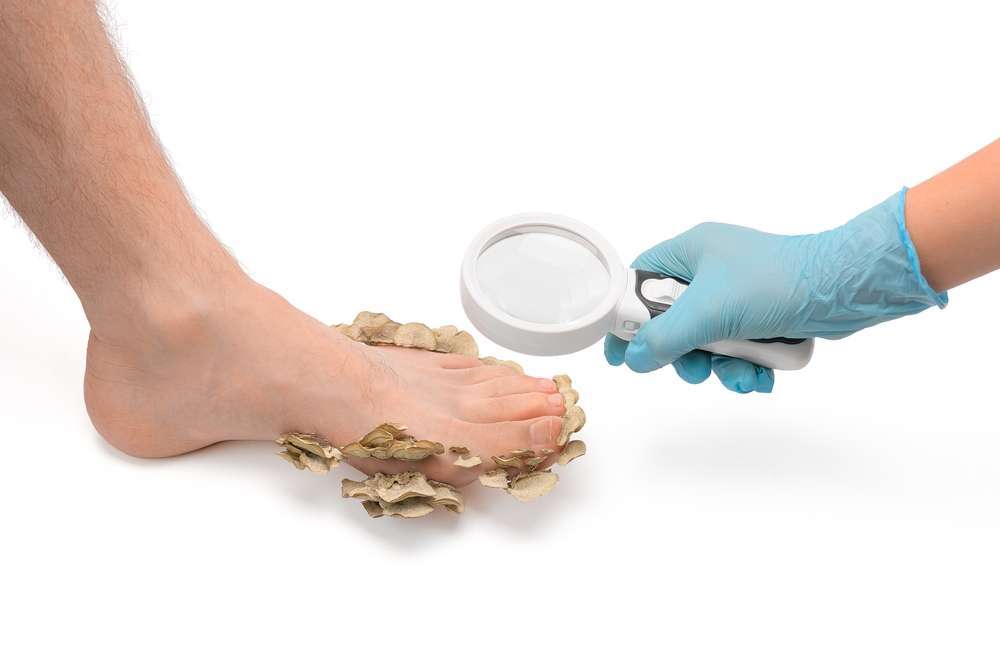Did you know there are different families of fungi? Not the tasty mushrooms you put in your favourite dishes, but rather the vicious fungi that can harm your feet. Dermatophytosis and onychomycosis are the two types of fungal infections that FootNetwork will introduce to you in this article. Here, we will look at the characteristics of each type, the people most at risk and the available treatments.
Dermatophytosis
Dermatophytosis refers to an infection brought on by a fungus called dermatophyte that damages our keratin (skin, hair or hair). Signs of this infection include lesions on the skin that appear as folds under the arms, on the toes, or on the scalp (ringworm). Avoid scratching the affected area, and schedule a visit with a podiatrist as soon as you can. It can affect both humans and animals. Dermatophytes belong to the genus of trichophyton, microsporum, and epidermophyton.
These infections have a variety of root causes. Due to the fungus’ contagiousness, it can spread through both close physical contact (such as during sexual activity or physical contact during sports) and remote contact (objects carrying the infection). If it came from an animal, it could have happened directly (through physical contact) or indirectly (their hair going everywhere). The people most at risk are children, adult women (for inflammatory lesions) and men (for hair and beard tinea). Pets, poor sanitation, public bathing, and combat sports can all contribute to the infection’s spread.
The two types of treatment are systemic and topical antifungals. To control the fungi in the area, a topical antifungal treatment involves the local application of an ointment, cream, or lotion. Systemic treatment consists of taking tablets of a griseofulvin or terbinafine-based medication for 5 to 8 weeks. It is used in addition to the antifungal treatment. It is important to be aware that there are some contraindications, such as during pregnancy. Therefore, it is always best to consult your podiatrist, who can make a diagnosis and adjust the course of treatment based on your condition. In addition, you will receive an abundance of helpful recommendations.
Athlete’s foot
Contrary to popular belief, not just athletes are affected by an athlete’s foot – in fact, it is the most common infection in podiatry. Unfortunately, these fungi thrive in the moist environment provided by sweaty feet. Its main symptoms include redness, lesions, itching, cracking, foul odours, blisters beneath the foot, burning, exfoliation, thickening, or whitening of the skin between the toes. We encourage you to read the FootNetwork article on this topic for more information.
Onychomycosis
Onychomycosis is the second largest type of foot fungi. Since “onych” means nail and “myco” means fungus, it is evident that these are nail fungi. When afflicted, the nails get progressively looser, thicker, more discoloured, broken, and smelly. Although it affects almost one in two seniors, 14% to 18% of the general population may also be impacted.
Walking barefoot in public, receiving a pedicure with unsterilized tools, sharing nail clippers, accidentally lifting your nail, or having an athlete’s foot are all risk factors for infection. To detect the infection and then choose the best course of treatment, various nail cultures will have to be collected. If you are interested in learning more about this topic, we invite you to read the FootNetwork blog post about it.
Nail fungus
Nail fungus is a fungal infection that causes physical deterioration of the nail and can lead to pain. This is why it is a good idea to see a podiatrist as soon as the issue manifests. Otherwise, treatment could become challenging. We advise you to prevent it by not wearing wet shoes or socks, maintaining short, clean nails, wearing sandals to the pool or public baths, and always thoroughly drying your feet after cleaning them.
You can remedy foot fungus
We are all susceptible to fungal infections. A moist environment is ideal for foot fungus growth. Being contagious, they may have been transmitted through human or animal contact. Depending on the kind of fungus that has developed, they can be treated in various ways. If it is dermatophytosis, there are systemic and antifungal remedies available. If it is a case of onychomycosis, your podiatrist will proceed with a nail culture. Your podiatrist will always be available to you for advice, guidance, and treatment. Contact them right away.

